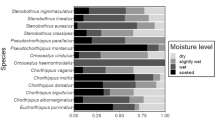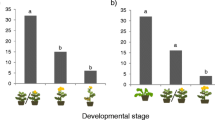Summary
Euphydryas gillettii in a montane meadow in Wyoming oviposits in clusters on the highest large leaves of its larval host, the shrub Lonicera involucrata. Egg masses are found on the underside of leaves which predominantly face the southeast and thereby intercept morning sun. Measurements of leaf temperatures show that, during the cool, clear mornings, these leaves are warmer than leaves of the opposite orientation. Manipulative experiments demonstrate that eggs on these slightly warmer microsites hatch significantly faster than eggs on leaves of other orientations. Because of the rapid onset of winter, an increased developmental rate is likely to correlate directly with increased fitness. The proximal mechanism yielding such a result may be that females choose oviposition sites in the shade.
Similar content being viewed by others
References
Ae SA (1958) Comparative studies of developmental rates, hibernation, and food plants in North American Colias (Lepidoptera, Pieridae). Am Midl Natl 60:84–96
Batschelet E (1972) Recent statistical methods for orientation data. In: SR Galler, K Schmidt-Koenig, GJ Jacobs, RE Belleville (eds), Animal orientation and navigation. NASA, Washington DC pp 61–91
Behan M, Schoonhoven LM (1978) Chemoreception of an oviposition deterrent associated with eggs in P. brassicae. Ent expl et Appl 24:163–179
Bowers MD (1978) Over-wintering behavior in Euphydryas phaeton (Nymphalidae). J Lepic Soc 32:282–288
Comstock JA (1940) Notes on the early stages of Euphydryas gillettii Barnes. Bull S Calif Acad Sci 39:111–113
Courtney SP (1980) Studies on the biology of the butterflies Anthocharis cardamines (L) and Pieris napi (L) in relation to speciation in Pierinae. PhD thesis, Univ of Durham
David WAL, Gardiner BOC (1962) Oviposition and the hatching of Pieris brassicae L in a laboratory culture. Bull ent Res 53:91–109
Ehrlich PR, Raven PH (1964) Butterflies and plants: A study in coevolution. Evolution 18:586–608
Gilbert LE (1975) Ecological consequences of a coevolved mutualism between butterflies and plants. In: LE Gilbert, PH Raven (eds), Coevolution of animals and plants. Univ Texas Press, Austin pp 210–240
Gilbert LE, Singer MC (1975) Butterfly ecology. Ann Rev Ecol Syst 6:365–397
Hitchcock CL, Cronquist A, Ownbey M, Thompson TW (1959) Vascular plants of the Pacific Northwest, Part 4, Ericaceae through Campanulaceae. Univ Washington Press, Seattle
Ilse D (1937) New observations on responses to colours in egg-laying butterflies. Nature 140:544–545
Ives PM (1978) How discriminating are cabbage butterflies? Aust J Ecol 3:261–276
Mitter C, Futuyma D, Schneider J, Hare J (1979) Genetic variation and host plant relations in a parthenogentic moth. Evolution 33:777–790
Mosher JA, White CM (1976) Directional exposure of golden eagle nests. Can Field-Nat 90:356–359
Rausher MD (1978) Search image for leaf shape in a butterfly. Science 200:1071–1073
Rausher MD (1979) Egg recognition: its advantages to a butterfly. Anim Behav 27:1034–1040
Rothschild M, Schoonhoven LM (1977) Assessment of egg load by Pieris brassicae (Lepidoptera, Pieridae). Nature 266:352–355
Rubink WL (1981) Edaphic correlates of nest site suitability in the sand wasp Bembix pruinosa Fox (Hymenoptera: Sphecidae). Manuscript
Saxena KN, Goyal S (1978) Host plant relations of the citrus butterfly Papilio demoleus L: orientational and ovipositional responses. Entomol Exp Appl 24:1–10
Schneider JC (1978) Phenological and kentromorphic aspects of the population ecology of the fall cankerworm Alsophila pometaria Harris (Lepidoptera: Geometridae) PhD thesis, Princeton Univ
Schweitzer DF (1979) Effects of foliage age on body weight and survival in larvae of the tribe Lithophanini (Lepidoptera: Noctuidae). Oikos 32:403–408
Shapiro AM (1980) Egg-load assessment and carryover diapause in Anthocharis (Pieridae). J Lepid Soc 34:307–315
Sherman PW, Watt WB (1973) The thermal ecology of some Colias butterfly larvae. J Comp Physiol 83:25–40
Singer MC (1971) Evolution of food-plant preferences in the butterfly Euphydryas editha. Evolution 35:383–389
Stanton ML (1979) The role of chemotactile stimuli in the oviposition preferences of Colias butterflies. Oecologia (Berl) 39:79–91
US Geological Survey (1962) Beartooth Butte, Wyoming, Quadrangle Map. 15 minute series (topographic), Denver
US National Oceanic and Atmospheric Administration (1978) Climatological data. Wyoming 65
Waterhouse FL (1960) The microclimatic zones near leaves and twigs and postural behavior of a geometrid larva. Inter Cong Entomol 11:689–693
Zar JH (1974) Biostatistical analysis. Prentice-Hall, Englewood Cliffs, NJ
Author information
Authors and Affiliations
Rights and permissions
About this article
Cite this article
Williams, E.H. Thermal influences on oviposition in the montane butterfly Euphydryas gillettii . Oecologia 50, 342–346 (1981). https://doi.org/10.1007/BF00344974
Received:
Issue Date:
DOI: https://doi.org/10.1007/BF00344974




